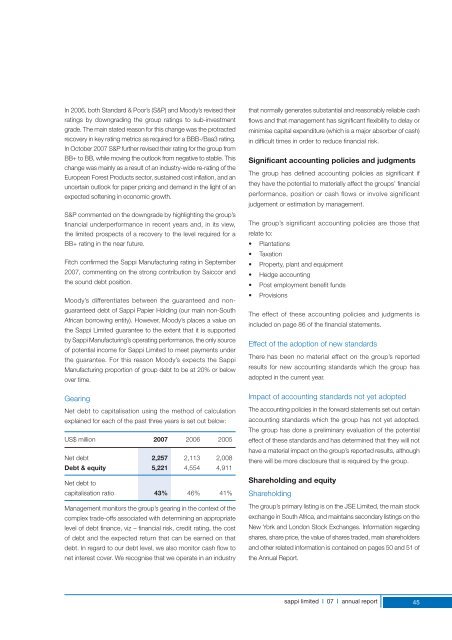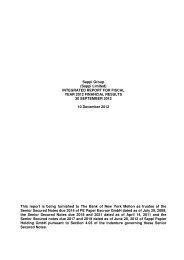2007 Annual Report - Sappi
2007 Annual Report - Sappi
2007 Annual Report - Sappi
Create successful ePaper yourself
Turn your PDF publications into a flip-book with our unique Google optimized e-Paper software.
In 2006, both Standard & Poor’s (S&P) and Moody’s revised their<br />
ratings by downgrading the group ratings to sub-investment<br />
grade. The main stated reason for this change was the protracted<br />
recovery in key rating metrics as required for a BBB-/Baa3 rating.<br />
In October <strong>2007</strong> S&P further revised their rating for the group from<br />
BB+ to BB, while moving the outlook from negative to stable. This<br />
change was mainly as a result of an industry-wide re-rating of the<br />
European Forest Products sector, sustained cost inflation, and an<br />
uncertain outlook for paper pricing and demand in the light of an<br />
expected softening in economic growth.<br />
S&P commented on the downgrade by highlighting the group’s<br />
financial underperformance in recent years and, in its view,<br />
the limited prospects of a recovery to the level required for a<br />
BB+ rating in the near future.<br />
Fitch confirmed the <strong>Sappi</strong> Manufacturing rating in September<br />
<strong>2007</strong>, commenting on the strong contribution by Saiccor and<br />
the sound debt position.<br />
Moody’s differentiates between the guaranteed and nonguaranteed<br />
debt of <strong>Sappi</strong> Papier Holding (our main non-South<br />
African borrowing entity). However, Moody’s places a value on<br />
the <strong>Sappi</strong> Limited guarantee to the extent that it is supported<br />
by <strong>Sappi</strong> Manufacturing’s operating performance, the only source<br />
of potential income for <strong>Sappi</strong> Limited to meet payments under<br />
the guarantee. For this reason Moody’s expects the <strong>Sappi</strong><br />
Manufacturing proportion of group debt to be at 20% or below<br />
over time.<br />
Gearing<br />
Net debt to capitalisation using the method of calculation<br />
explained for each of the past three years is set out below:<br />
US$ million <strong>2007</strong> 2006 2005<br />
Net debt 2,257 2,113 2,008<br />
Debt & equity 5,221 4,554 4,911<br />
Net debt to<br />
capitalisation ratio 43% 46% 41%<br />
Management monitors the group’s gearing in the context of the<br />
complex trade-offs associated with determining an appropriate<br />
level of debt finance, viz – financial risk, credit rating, the cost<br />
of debt and the expected return that can be earned on that<br />
debt. In regard to our debt level, we also monitor cash flow to<br />
net interest cover. We recognise that we operate in an industry<br />
that normally generates substantial and reasonably reliable cash<br />
flows and that management has significant flexibility to delay or<br />
minimise capital expenditure (which is a major absorber of cash)<br />
in difficult times in order to reduce financial risk.<br />
Significant accounting policies and judgments<br />
The group has defined accounting policies as significant if<br />
they have the potential to materially affect the groups’ financial<br />
performance, position or cash flows or involve significant<br />
judgement or estimation by management.<br />
The group’s significant accounting policies are those that<br />
relate to:<br />
• Plantations<br />
• Taxation<br />
• Property, plant and equipment<br />
• Hedge accounting<br />
• Post employment benefit funds<br />
• Provisions<br />
The effect of these accounting policies and judgments is<br />
included on page 86 of the financial statements.<br />
Effect of the adoption of new standards<br />
There has been no material effect on the group’s reported<br />
results for new accounting standards which the group has<br />
adopted in the current year.<br />
Impact of accounting standards not yet adopted<br />
The accounting policies in the forward statements set out certain<br />
accounting standards which the group has not yet adopted.<br />
The group has done a preliminary evaluation of the potential<br />
effect of these standards and has determined that they will not<br />
have a material impact on the group’s reported results, although<br />
there will be more disclosure that is required by the group.<br />
Shareholding and equity<br />
Shareholding<br />
The group’s primary listing is on the JSE Limited, the main stock<br />
exchange in South Africa, and maintains secondary listings on the<br />
New York and London Stock Exchanges. Information regarding<br />
shares, share price, the value of shares traded, main shareholders<br />
and other related information is contained on pages 50 and 51 of<br />
the <strong>Annual</strong> <strong>Report</strong>.<br />
sappi limited | 07 | annual report 45
















